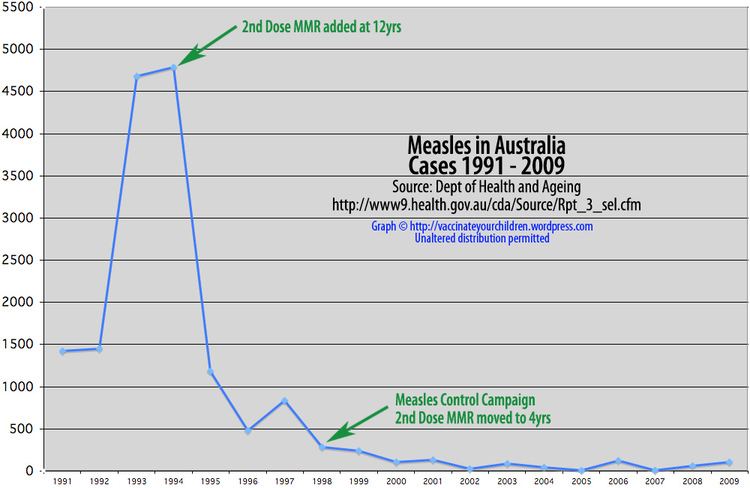 | ||
The Australian Measles Control Campaign was initiated in August 1998 as part of the World Health Organisation's global Measles eradication program, and in response to major epidemics in Australia throughout 1994/95, together with a report predicting another impending measles epidemic in Australia. The campaign vaccinated 1.78 million children, making it the largest national vaccination campaign conducted in Australia since the introduction of poliomyelitis vaccination in 1956.
Contents
The campaign was promoted using the slogan Let's Work Together to Beat Measles
The Campaign
Following the World Health Organization's adoption of a 2010 target date for Global Measles eradication and the notation that a single dose vaccination strategy was ineffective, the Federal Health Department began investigating the options for a measles eradication campaign in Australia. In 1996 and 1997, seroserveys were conducted in South Australia and New South Wales to assess the current levels of measles immunity. Results indicated that there were "probably enough susceptible children in the South Australian population to support a measles epidemic". In November 1997, a workshop of experts was formed to discuss the logistical, funding and surveillance issues of a potential measles elimination campaign. The group concluded that the 2nd dose of MMR should be brought forward from 12 years to 4 years (in line with WHO recommendations), and that a school-based campaign be implemented. Three groups would be targeted for vaccination:
Objectives
Statistics
Results
Criticisms of the Campaign
Anti-vaccination lobby group, the Australian Vaccination Network attacked the program both prior to commencement and as it progressed, asking their members to "Do anything and everything you can to ensure that this vaccination campaign does not take place". Their reasons for opposing the program included claims that the vaccine was not effective and that the Government was severely understating the risks and possible adverse reactions which would result from the program. The AVN claimed to have filed a Federal Court injunction and other legal action against both the campaign and the Federal Health Minister, however no such action eventuated. In a July 1998 article entitled "Bully Boy Tactics", the AVN made dire predictions of adverse reactions that would result from the program, which are compared in the table below to the actual results:
In response to the AVN's campaign, the then Federal Health Minister Dr Michael Wooldridge issued a media release which was critical of the group, writing:
"I am deeply concerned that media organisations risk giving credibility to the crackpot views of the AVN by publishing, without question, their untrue and deceitful claims. Ultimately, young children who are particularly vulnerable to measles could suffer if their parents were influenced by the anti-science, irrational views of the AVN."